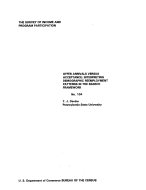Offer Arrivals Versus Acceptance: Interpreting Demographic Reemployment Patterns in the Search Framework
Offer Arrivals Versus Acceptance: Interpreting Demographic Reemployment Patterns in the Search Framework
The structure of the stationary job search model is now familiar. The unemployed worker searches each period for wage offers from some distribution of possibilities; with some probability, an offer is secured. The worker knows both the distribution of offers and the probability of receiving an offer. Uncertainly exists because the worker does not know which firms are making which offers. When an offer is received, the worker must choose between accepting the offer or continuing the search. Suppose that the worker’s objective is maximization of the discounted value of lifetime income, that unemployment income net of search costs does not change as a spell continues, and that the worker expects to hold any job taken for a long time. The optimal policy for the worker in this case is to accept the first offer that exceeds a time-invariant reservation wage—this being the wage which equates the marginal cost and marginal benefit of continued search.
Others in Series
Working Paper
Working Paper
Working Paper




